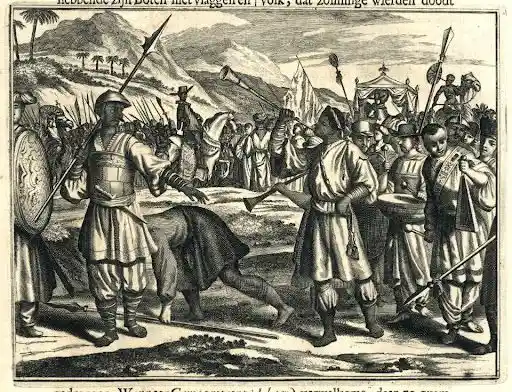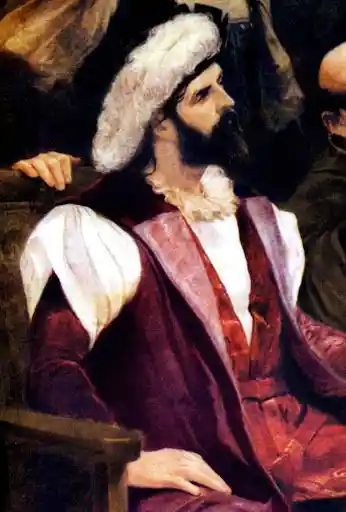The Portuguese Quest for Indian Pepper
The city of spices. The all-consuming and peppery aroma of the spices of Calicut travelled to the land of Portugal, where King Manuel I couldn’t resist the temptation and decided to venture into the trade of spices. A nobleman who would boost the economy of the land and ensure Portuguese monopoly in the Indian Ocean was needed. There was only one man who could conduct the job flawlessly, limiting losses and increasing the Portuguese power—Vasco da Gama.

Vasco Da Gama arriving at the ports of Calicut. Image Source: Creazilla
The mission at hand was to get in direct contact with the riches of India and use it for personal gain. The probable riches and power that Portugal might become the overlord of were very high and hence, the travel risks and opportunity costs were swept under the carpet. With four ships filled with three years of supplies and cheap goods for trade, Vasco da Gama embarked on a journey that would span multiple months, passing through the horrendous stagnation of the Central Atlantic before reaching the Cape of Good Hope. After more than three months of sailing, with his voyagers suffering from scurvy and hunger, Vasco da Gama reached Mozambique in 1498, going on to travel through Malaysia, the islands of Indonesia, and then China.
Tired from travelling through different lands, his resources exhausted, da Gama and his troops arrived at Mombasa, only to find hostility from the locals. After a series of negotiations, Da Gama ventured deep into the port of Mombasa with his troops, where they met sailors who would finally take him to the port of his dreams—Calicut. Interestingly, da Gama felt that there were certain similarities between Hinduism and Christianity, going so far as to mistake the Hindu sailors for Christians.
Taking a route from Mombasa to Malindi, they set off for Calicut from the latter port and arrived at their destination in less than a month. Finally in India, the land of gold, they were ready to dive into trade with this diverse country.
On his arrival, he was greeted by the Hindu king of Calicut, the Zamorin. However, da Gama’s first impression was quite wrong and the gifts he offered to the king were rejected. Starting off on the wrong foot, it became difficult for Vasco da Gama to initiate trade. After an intense cold war, the Zamorin agreed to allow minor trade, provided that the foreigners pay taxes, just like every other merchant.
Frustrated with the non-profitable deal and difficult climatic conditions that led to the loss of his companions, the troops travelled back to Portugal haphazardly, incurring a huge human loss. The only motivation for Vasco da Gama after losing his brother on the port of Cape Verde while travelling back was the graceful and main-character welcome he received once he reached Portugal. The small quantity of spice he took with him to Portugal hinted at potential long-term benefits.
Once da Gama settled down back in Portugal, King Manuel I and his chiefs laid down a strategic plan to conquer all the major ports of the Indian Ocean. A now-or-never situation, Manuel was ready to give his all to gain a monopoly of trade in the East. The Portuguese were ready to maim the lands and extract as many resources as possible.
The first expedition was to be led by Cabral, who was assigned with two goals — the conversion of Hindus to Christianity and bringing back an abundance of spices to sell.
Cabral, with a total of thirteen vessels and ample troops, set out on his voyage to India on 9 March 1500 and reached Calicut on 13 September. Eager to rectify da Gama’s mistakes, Cabral was adamant on making a good impression on the Zamorin. He, to this end, presented shiploads of luxurious goods and an official letter from King Manuel for the perusal of this Hindu king.
This formal greeting ensured a start to a commercial relationship between the two kingdoms — the Zamorin signed a treaty with the Portuguese, permitting them to set up their factories in Calicut to process and sell the famous Indian spices.
The Portuguese were finally another step closer to their dream of monopolising the Indian Ocean and being the true kings of the spice trade. However, power-hungry officials do leave dirt marks laced with greed when they walk. Cabral couldn't handle the fact that the Zamorin was also trading with the Arabs and initiated a plan to seize an Arab merchant ship loaded with spices. Angry with this sudden outburst of might by the Portuguese, the Arabs retaliated, killing over 50 Portuguese men. This led to the beginning of a naval war between the Arabs and the Portuguese.
Cabral couldn’t handle the loss of his troops and decided to seize ten other Arab ships, looting their shipments, killing their men, and ensuring that the fallen ashes of the burning ships were carried away the rushing waters of the Indian Ocean. While one would think that this carnage would quench his anger, that didn't happen. His fury took over his capability to make rational decisions, and he bombarded the port of Calicut.
After regaining his senses and becoming aware of the consequences of his actions, Cabral left the burning ports of Calicut on the eve of Christmas and reached the port of Cochin to seek refuge without giving up on his mission to exploit. His stay in Cochin was short-lived, but it lasted long enough for him to fill his ships with pepper. Within a month, he received the news that the Zamorin was sending his warships to Cochin to attack the Portuguese. He fled as quickly as possible and arrived back at the ports of Lisbon with enough spice for him to turn into another hero of the Portuguese navy. However, the pepper was just an entry into their economic and political standing in the Indian Ocean. A big impact was still to be made.

Pedros Cabral. Image Source: Wikipedia


